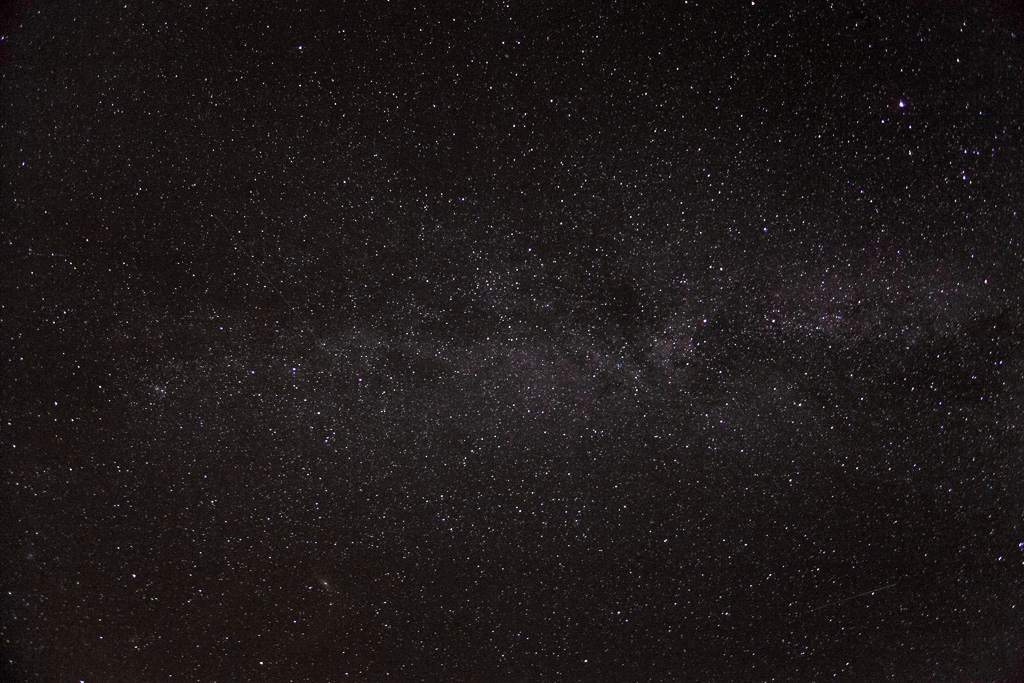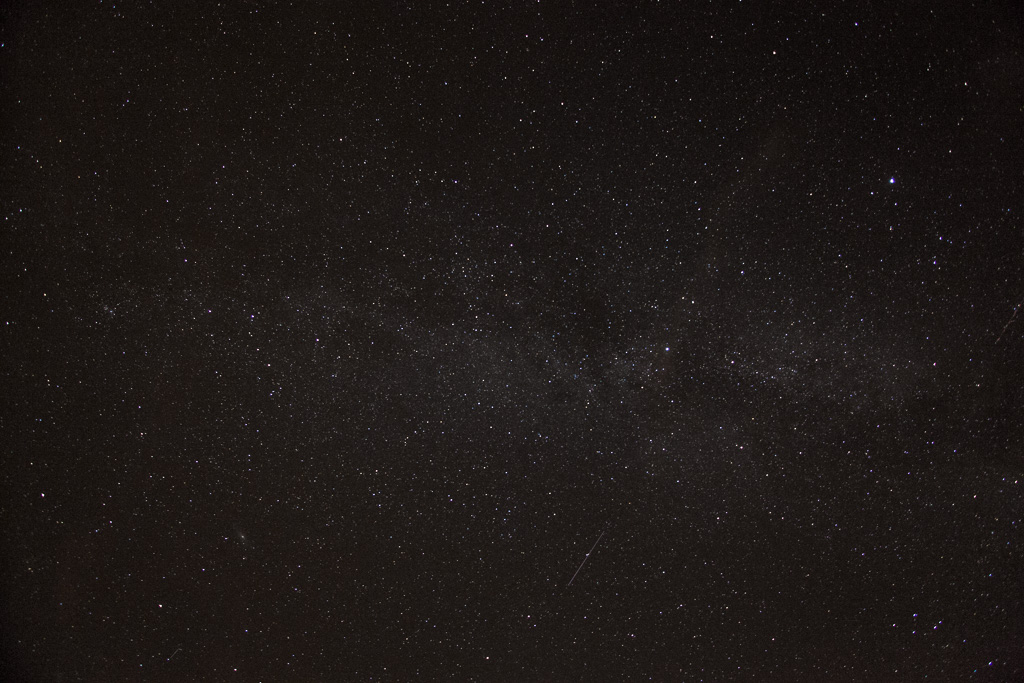This article was reposted on the Caught by the River website on 20th October 2015.
Anglesey in early September. An excellent pub meal for two, followed by a DVD and a couple of bottles of wine back at the caravan: another perfect end to another perfect day.
It’s getting late. Almost time for bed. But I need to check something first, just in case. I open the caravan door, and lean out.
“HOLY CRAP! COME AND LOOK AT THIS!”
I stagger out into the field, calling to Jen to turn off the caravan lights before joining me. Seconds later, we’re standing side-by-side in the dark, gawping open-mouthed into the heavens.
“Wow!” says Jen, in the sort of hushed tone usually reserved for cathedrals.
✽
It was here, in Anglesey, in the field on the other side of the hedge, that I first saw the stars. Saw them properly, I mean. Saw them as they ought to be seen—as our ancestors saw them. I was only a kid at the time, but I’ve never forgotten looking up at the night sky with my parents and sister on our way to the campsite loos, and being astonished at the number of stars. We even spotted a couple of satellites. So, not quite as our ancestors saw them, then.
In all my years living on my native Wirral, and in my twenty-plus years in the West Yorkshire Pennines, I’ve never seen stars remotely approaching those in Anglesey. There are so damn many of them. Thousand upon thousand. Too many to count. It’s disorientating. With all these stars, it becomes difficult to identify even the most familiar of constellations. It’s like trying to spot friends’ faces in a crowd. They’re up there all right, but they’re lost in the throng.
Even more disorientating is the whole distorted perspective thing. On a clear night like tonight, an individual star’s apparent brightness is determined by both its actual brightness and its distance from you. If you double your distance from a light-source, its apparent brightness drops to a quarter. It’s basic physics: an inverse-square law. But, when you look up at an Anglesey night sky, your mind plays tricks on you. Well, mine does at least. It forgets that stars really do have different brightnesses. It assumes that all of the stars you’re looking at must be equally bright, so any differences in their apparent brightness must be due solely to differences in their distances. Your brain processes the signals from your optic nerves, calibrates them using the inverse-square law, and presents your mind with a stunning, totally distorted 3-D rendition of the night sky, in which the Z-axis appears to be on some sort of acid-trip. These tiny points of light are trillions of miles away, yet your brain cons you into thinking you can judge their relative distances. They feel so close. It’s like looking down a well. You feel as if you’re going to fall; fall upwards, up into the stars. Your brain reels. Upside-down vertigo. Invertigo.
Jen’s right. There is no other word for it: Wow!
“I have to try to photograph this,” I say.
✽
Five minutes later, I’m heading down the field, camera and tripod in hand. The three other caravans in the field are giving out too much light. I need more dark. I know just the place.
It shouldn’t be so unusual to see the firmament it all its glory like this, but, as a species, we’ve done our utmost to banish darkness from our lives. Don’t get me wrong, I appreciate being able to read a book late into the evening by artificial light, rather than having to retire to bed when the sun sets, but we’ve taken our aversion to the dark too far. Street lighting has its place, I suppose, but do we really need quite so much of it? And as for home security lights, well, don’t get me started. “Why do they even bother moving to the countryside?” asked my friend Carolyn, as we walked her dog past her new neighbours’ house a few winters ago. The house was down a formerly dark country lane, but it was lit up like a Vegas casino.
Light pollution is one of those conveniently overlooked drawbacks of the modern world. It might not be as pressing as global climate change, habitat destruction, or a host of other evils that are supposed to be worrying the hell out of us these days, but light pollution is still pretty indefensible when you think about it. Not that you ever do. You’ve become accustomed to it. You look up into the night sky, you see a handful of stars, and you think that’s how it’s supposed to look.
✽
I follow the Milky Way north-east down the field towards the sea. It seems odd, but I’ve spoken with people who didn’t realise that the Milky Way is actually a thing; who thought it was just a poetic pseudonym for the stars at night. No, the Milky Way is a long, thin, glowing streak of white, slanting across the sky from horizon to horizon, circling the Earth. It’s where most of the stars are to be found, when they can be found at all, grouped at a far higher density than elsewhere in the night sky.
The Milky Way fascinated our ancestors for millennia. They invented all sorts of stories to explain it. The ancient Egyptians reckoned it was the milk of a divine cow; the Cherokees, cornmeal spilt by a thieving dog; the people of the Kalahari, glowing embers; the ancient Greeks, the breast-milk of Hera, inadvertently spurted across the sky when she awoke to find herself unwittingly suckling the infant Heracles. All very poetic, but, as with all such myths, utter nonsense. It wasn’t until the invention of the telescope that we were able to confirm that the faint, white glow forming the backdrop of the stars of the Milky Way itself comprises many thousands more individual stars too small and dim to discern with the naked eye; and it wasn’t until the mid-eighteenth century that a mathematician and astronomer from the North East of England, Thomas Wright, hypothesised that the Milky Way was “an optical effect due to our immersion in what locally approximates to a flat layer of stars”.
We now know that we are indeed located within a flattish layer of stars: a spiral galaxy, at least 100,000 light-years across, containing several hundred billion stars. Like I said, too many to count. The Milky Way trail in the night sky is what we see, if we can see it at all, when we look out through the flat plane of our galaxy: the eponymous Milky Way Galaxy. We also now know that our enormous galaxy is just one amongst around 100 billion galaxies in the observable universe.
Be honest, now, isn’t that better than some ridiculous story about spilt milk: knowing that there are at least fourteen times as many entire galaxies out there as there are people on this wonderful, totally insignificant little planet? Anyone who claims that modern science has somehow destroyed our sense of wonder, or belittled the natural world, needs to have their head seen to.
✽
I reach the edge of the low headland, and search for the path down to the rocks. It’s a path I’ve taken hundreds of times, but this is the first time I’ve tried it at night, carrying a bulky tripod, with a bottle of Nero d’Avola inside me. It’s perfectly safe, but I’m glad I thought to bring a torch.
After a bit of a scramble, I set up my tripod at the foot of the path in a right-angle of rock-faces. The rocks block out the light from the campsite, and from the obscenely bright floodlights glaring across the bay from the new lifeboat station. Why are they allowed to get away with that sort of thing? Even here, however, in my shady corner, it’s not completely dark: far to the east, Llandudno glows orange and menacing on the horizon. Still, as I hoped, the stars look even more fantastic from down here.
I’ve already fitted a wide-angle lens to my camera, to capture as many stars as possible. I make a few minor adjustments to the tripod, then aim the camera more or less straight up into the sky, vaguely in the direction of what I presume to be the usually unmistakeable W-shaped constellation of Cassiopeia, although its hard to tell for sure with all of these stars. I then disengage autofocus, turning the manual focus ring to infinity; set the ISO to maximum; set the aperture to its second-widest (because I vaguely remember reading that’s best when photographing stars); set the exposure to 30 seconds (an educated guess); and set the shutter to release after a two-second delay, to avoid camera-shake. As an afterthought, I somehow remember to cover the eyepiece of the camera to prevent extraneous light getting in through the back-window. I then depress and release the shutter-button and stand back. There’s a soft clunk as the mirror rises, and a second clunk half a minute later as it drops again. The screen on the back of the camera lights up briefly with a miniature view of the heavens, then all is dark once more. I fire off several more shots, experimenting with different settings, just in case, then head off back to the caravan, where bed awaits.
✽

Award yourself five points if you can spot the familiar W-shape of Cassiopeia in amongst the crowd, and five additional points if you spot the fuzzy blob of the Andromeda Galaxy.
The following morning, I’m pleasantly surprised with the results of my first proper attempt at astrophotography. The photos will need a bit of tweaking in post-production to bump up the contrast, but not bad, all things considered. Some of the photos show one or more long, thin streaks of light: the trails of satellites as they passed overhead. There, as I thought, to the left of centre, hangs Cassiopeia, almost lost amongst the other stars of the Milky Way. And there, just below her—if the word below can be applied in space—in the constellation named after Cassiopeia’s daughter, spins a minuscule, fuzzy blob: the Andromeda Galaxy, the Milky Way’s big sister, a mere 2½ million light-years away, hurtling on a collision course towards us through the inconceivable vastness of space.

Leave a Reply